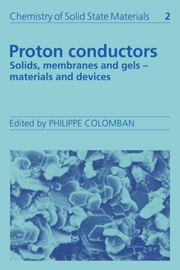Book contents
- Frontmatter
- Contents
- List of contributors
- Preface
- Symbols
- I HYDROGEN BOND AND PROTONIC SPECIES
- II MATERIALS: PREPARATION, STRUCTURES AND PROPERTIES
- 7 Structure and characterization of hydrogen insertion compounds of metal oxides
- 8 High temperature proton conductors based on perovskite-type oxides
- 9 Highly ionic hydroxides: unexpected proton conductivity in Mg(OH)2 and homologues
- 10 Ice
- 11 Anhydrous materials: oxonium perchlorate, acid phosphates, arsenates, sulphates and selenates
- 12 Hydrogen behaviour in graphite–nitric acid intercalation compounds
- 13 Proton-containing β- and β″-alumina structure type compounds
- 14 Proton conduction in zeolites
- 15 Proton containing NASICON phases
- 16 Phosphates and phosphonates of tetravalent metals as protonic conductors
- 17 Hydrogen uranyl phosphate, H3OUO4PO4. 3H2O (HUP), and related materials
- 18 From crystalline to amorphous (particle) hydrates: inorganic polymers, glasses, clays, gels and porous media
- 19 Perfluorinated membranes
- 20 Mixed inorganic-organic systems: the acid/polymer blends
- III PROTON DYNAMICS AND CHARGE TRANSPORT
- IV PROTON DIFFUSION MECHANISMS
- V DEVICES
- Index
18 - From crystalline to amorphous (particle) hydrates: inorganic polymers, glasses, clays, gels and porous media
Published online by Cambridge University Press: 04 May 2010
- Frontmatter
- Contents
- List of contributors
- Preface
- Symbols
- I HYDROGEN BOND AND PROTONIC SPECIES
- II MATERIALS: PREPARATION, STRUCTURES AND PROPERTIES
- 7 Structure and characterization of hydrogen insertion compounds of metal oxides
- 8 High temperature proton conductors based on perovskite-type oxides
- 9 Highly ionic hydroxides: unexpected proton conductivity in Mg(OH)2 and homologues
- 10 Ice
- 11 Anhydrous materials: oxonium perchlorate, acid phosphates, arsenates, sulphates and selenates
- 12 Hydrogen behaviour in graphite–nitric acid intercalation compounds
- 13 Proton-containing β- and β″-alumina structure type compounds
- 14 Proton conduction in zeolites
- 15 Proton containing NASICON phases
- 16 Phosphates and phosphonates of tetravalent metals as protonic conductors
- 17 Hydrogen uranyl phosphate, H3OUO4PO4. 3H2O (HUP), and related materials
- 18 From crystalline to amorphous (particle) hydrates: inorganic polymers, glasses, clays, gels and porous media
- 19 Perfluorinated membranes
- 20 Mixed inorganic-organic systems: the acid/polymer blends
- III PROTON DYNAMICS AND CHARGE TRANSPORT
- IV PROTON DIFFUSION MECHANISMS
- V DEVICES
- Index
Summary
Protonic conduction is encountered in a series of ‘composite’ compounds ranging from clays to ‘porous’ polymer structures via gels. In all these materials the distinction between the host lattice and protonic species becomes difficult because of the ‘softening’ of the rigid lattice. The rigid framework can be composed of big ions such as Keggin salts (d ∼ 2.5 nm), amorphous inorganic polymers (d ∼ 2.5–10 nm) or very small crystallites or particles such as the well-known clay minerals (d – 50–100 nm) (Fig. 18.1). The latter can also be prepared in the gel state if interaction with water is sufficiently strong. Some other materials, zirconium phosphate hydrate, Zr(HPO4)2.nH2O, for instance, can be obtained in the crystalline, amorphous and gel states. The formation of a gel depends on the existence of defects involving both the framework and associated protonic species and can be described in the following way: ‘dissolution’ of the host lattice leads to the formation of an associated water layer between solid and liquid, the increase of the solid–liquid interface being correlated. Here can also be cited the alteration phenomena of well-known silicoaluminates (mica, feldspar) in clays by proton exchange of first and second group cations. Fig. 18.2 summarizes the relationships existing between these materials and those discussed in the preceding chapters, ((β-alumina, NASICON and HUP). The differentiation between the structure and properties of ‘surface’ and ‘bulk’ remains valid if a chemically and thermally stable framework, i.e. of low ‘water’ content, is considered.
- Type
- Chapter
- Information
- Proton ConductorsSolids, Membranes and Gels - Materials and Devices, pp. 272 - 293Publisher: Cambridge University PressPrint publication year: 1992
- 2
- Cited by



